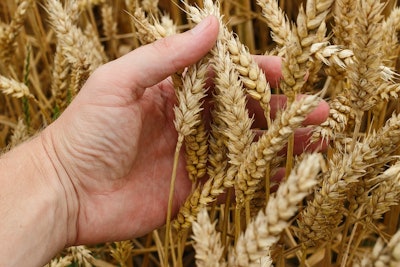
The USDA has released itsWorld Agricultural Supply and Demand Estimates (WASDE)for April.
WHEAT:The outlook for 2019/20 U.S. wheat is for lower exports, reduced domestic use, and increased ending stocks. The NASS Grain Stocks report, issued March 31, implied less feed and residual disappearance for both the second and third quarters than previously estimated. Total 2019/20 feed and residual use is trimmed 15 million bushels to 135 million.
小麦出口也减少到9 1500万蒲式耳85 million on a slowing pace and prices that have become uncompetitive in many international import markets. By class, Hard Red Winter and Soft Red Winter are reduced 10 million and 5 million bushels, respectively. The changes result in a 30 million bushel increase in estimated all wheat ending stocks to 970 million.
Despite the larger ending stocks, the projected season-average farm price is raised $0.05 per bushel to $4.60 on updated NASS data as well as surging nearby cash and futures prices, partially resulting from the global COVID19 pandemic.
The 2019/20 global outlook is for slightly higher supplies, but reduced trade and utilization. Global production is lowered fractionally with several small mostly offsetting changes. Global exports are lowered 0.9 million tons, led by a 1.5-million-ton reduction for Russia, which was directly offset by an equivalent increase for the EU. The Russia change is based primarily on newly imposed government export restrictions.
The EU is raised on less competition from Russia as well as expectations of a continued strong pace of exports. Several smaller export reductions are made; notably a 0.4-million-ton reduction for the United States and a 0.3-million-ton reduction for Pakistan. Global imports are reduced 0.3 million tons each for Brazil, Japan, and Uzbekistan; a 0.3-millionton increase for Morocco is partially offsetting.
Aggregate world consumption is lowered 5.1 million tons following updates to several countries. The largest reductions are 2.0 million tons for China, 1.9 million for India, and 1.0 million for the EU. With supplies higher and use down, projected 2019/20 global ending stocks are raised 5.6 million tons to a record high 292.8 million.
COARSE GRAINS:This month’s 2019/20 U.S. corn outlook is for reduced imports, greater feed and residual use, lower food, seed, and industrial use, and larger stocks. Feed and residual use is raised 150 million bushels to 5.675 billion. This is based on corn stocks reported as of March 1 which indicated disappearance during the DecemberFebruary quarter rose about 4 percent relative to a year ago.
较低的预测玉米用于乙醇也支持larger feed and residual use. Corn used to produce ethanol is lowered 375 million bushels to 5.050 billion based on the latest indications from Energy Information Administration data indicating an unprecedented decline in ethanol production and motor gasoline consumption as a result of COVID-19.
Partly offsetting is a forecast increase in the amount of corn used for alcohol for beverages and WASDE-599-2 manufacturing use. With supply down fractionally and use declining, ending stocks are raised 200 million bushels to 2.092 billion.
The season-average marketing weighted corn price received by producers is lowered 20 cents to $3.60 per bushel. The global coarse grain production forecast for 2019/20 is up 1.0 million tons to 1,403.8 million.
This month’s foreign coarse grain outlook is for larger production, lower trade, fractionally higher use, and larger stocks relative to last month.
Corn production is raised for the EU and Belarus, with partly offsetting reductions for Indonesia and Laos. Major global trade changes for 2019/20 include higher projected corn exports for the EU, with a partially offsetting reduction for Russia. Corn imports are raised for South Korea, Turkey, Algeria, and Indonesia, with lower projections for Vietnam, Taiwan, Cuba, and Mexico. Foreign corn ending stocks are raised, mostly reflecting increases for Thailand, Taiwan, India, and Turkey that more than offset declines for Argentina and Mexico. Global corn ending stocks, at 303.2 million tons, are up 5.8 million from last month.
OILSEEDS:U.S. soybean supply and use changes for 2019/20 include lower exports, seed use, and residual use, higher crush, and higher ending stocks. Soybean exports are reduced mainly on strong competition from Brazil. Lower seed use reflects plantings for the 2020/21 crop indicated in the March 31 Prospective Plantings report. Residual WASDE-599-3 use is reduced based on indications in the March 31 Grain Stocks report.
Soybean crush is raised on higher soybean meal exports and increased domestic disappearance. Domestic soybean meal use is forecast higher with an expected reduction in available supplies of DDGs resulting from lower ethanol production. With higher crush only partly offsetting lower exports, seed, and residual use, ending stocks are projected at 480 million bushels, up 55 million.
The season-average soybean price is forecast at $8.65 per bushel, down 5 cents. The soybean oil price is projected at 30.0 cents per pound, down 1.5 cents reflecting increased production and ending stocks. Soybean meal prices are unchanged at $305 per short ton. The 2019/20 global oilseed outlook includes lower production, exports, and stocks compared to last month. Global soybean production is reduced 3.7 million tons to 338.1 million on lower production for Argentina and Brazil. Argentina’s production is lowered 2 million tons to 52 million, reflecting dry conditions in the main growing regions during the latter part of February into early March.
Soybean production for Brazil is lowered 1.5 million tons to 124.5 million due to dry conditions in Rio Grande do Sul while the crop was in pod-filling and maturation stages.
Global soybean exports are lowered 0.4 million tons to 151.5 million. U.S. and Canadian exports are lowered while Brazil’s shipments are revised up due to a competitive exchange rate and ample exportable supplies. China’s imports are raised 1 million tons to 89 million, reflecting higher Brazilian shipments.
Global soybean ending stocks are 2.0 million tons lower than last month as lower stocks in Brazil are partly offset with higher U.S. and Chinese stocks.





















